- 昨日は国立大学(前期)入学試験の初日。京都大学でも国語と数学の試験がありました。
- こちらに数学の試験問題(と解答)があります
- 解説はお任せするとして、Rの練習課題として扱ってみましょう
- (1)複素数と複素数での変換の話
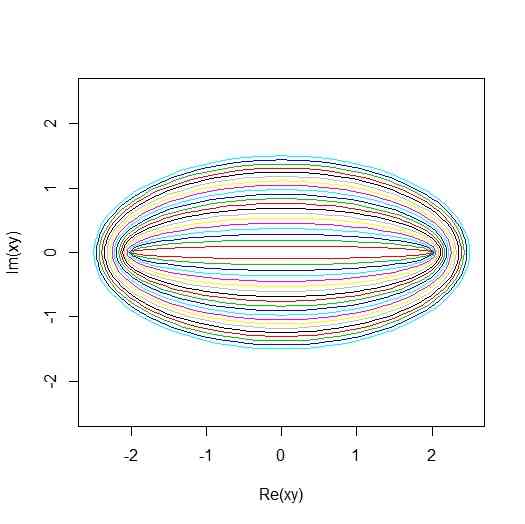
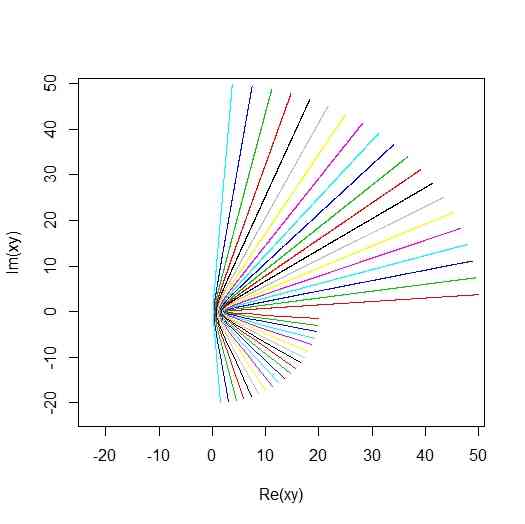
R <- 2
thetas <- seq(from=0,to=2*pi,length=101)
ws <- R * cos(thetas) + R * 1i * sin(thetas)
xy <- ws + 1/ws
xlim <- ylim <- range(c(Re(xy),Im(xy)))
plot(xy,type="l",xlim=xlim,ylim=ylim)
Rs <- seq(from=1,to=2,length=21)
Rs <- Rs[-1]
for(i in 1:length(Rs)){
R <- Rs[i]
ws <- R * cos(thetas) + R * 1i * sin(thetas)
xy <- ws + 1/ws
xlim <- ylim <- range(c(Re(xy),Im(xy)))
points(xy,type="l",xlim=xlim,ylim=ylim,col=i+1)
}
alpha <- pi/3
Rs <- seq(from=0,to=50,length=1000)
Rs <- Rs[-1]
ws <- Rs * cos(alpha) + Rs * 1i * sin(alpha)
xy <- ws + 1/ws
xlim <- ylim <- range(c(Re(xy),Im(xy)))
xlim[1] <- xlim[1]-5
xlim[2] <- xlim[2]+5
ylim[1] <- ylim[1]-5
ylim[2] <- ylim[2]+5
plot(xy,type="l",xlim = xlim,ylim=ylim)
alphas <- seq(from=0,to=pi/2,length=22)
alphas <- alphas[-1]
alphas <- alphas[-length(alphas)]
for(i in 1:length(alphas)){
alpha <- alphas[i]
ws <- Rs * cos(alpha) + Rs * 1i * sin(alpha)
xy <- ws + 1/ws
points(xy,type="l",col=i+1)
}
- (2)3次元の図形。ベクトル。座標の自由度など
- 平行になること、斜めになること、きれいな正八面体になること
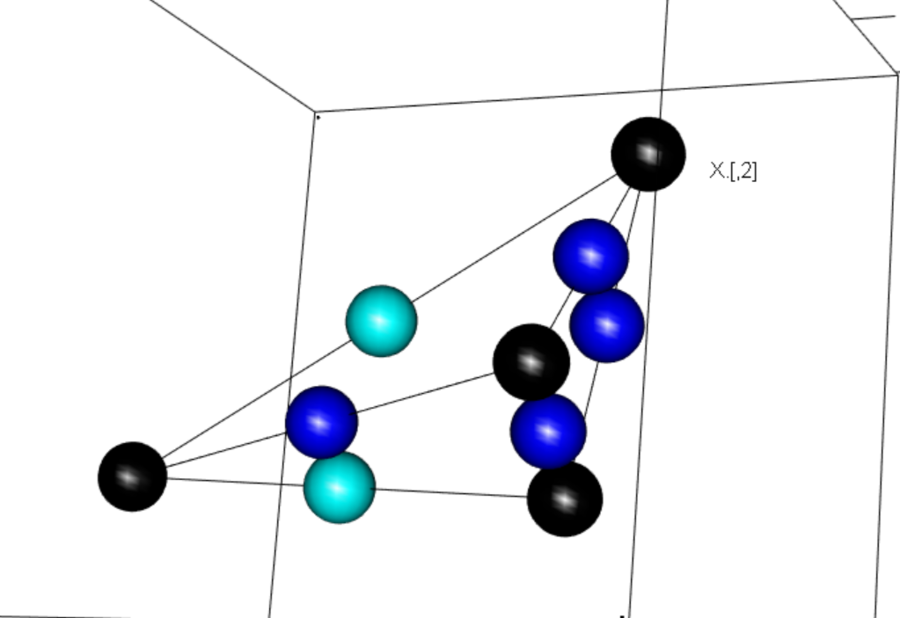
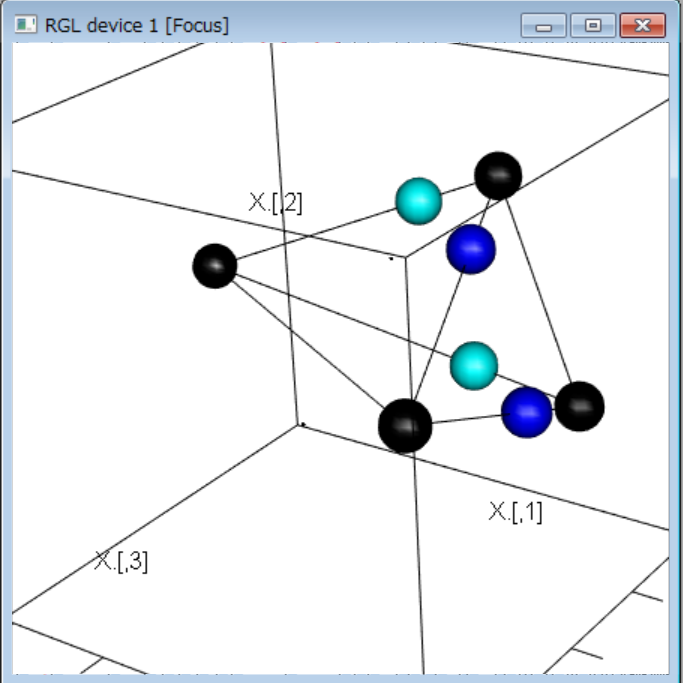
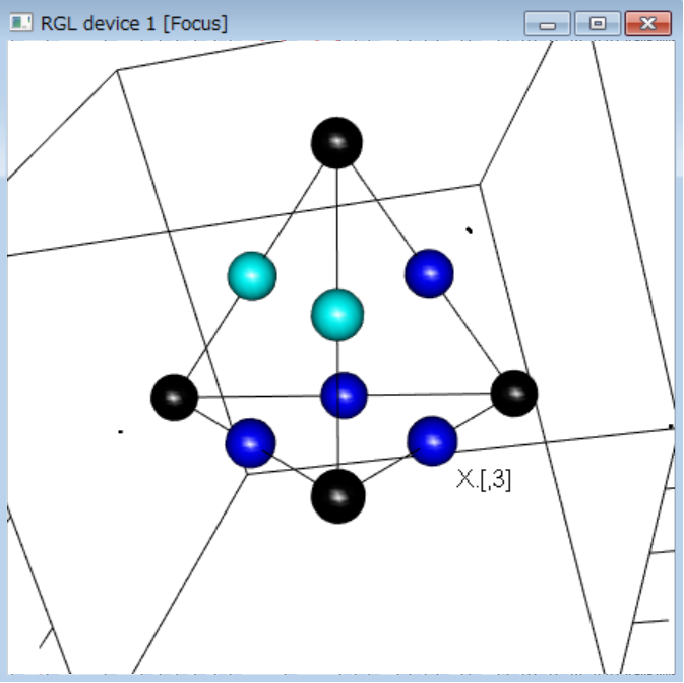
X <- matrix(rnorm(3*4),ncol=3)
X <- X/sqrt(apply(X^2,1,sum))
X. <- rbind(X,c(1,1,1))
X. <- rbind(X.,c(-1,-1,-1))
library(rgl)
plot3d(X.,)
spheres3d(X,radius=0.1)
r <- runif(6)
cnt <- 1
for(i in 1:3){
for(j in (i+1):4){
segments3d(X[c(i,j),])
tmp <- X[i,] * r[cnt] + X[j,] * (1-r[cnt])
spheres3d(tmp,color=2,radius=0.1)
cnt <- cnt+1
}
}
r2 <- r
r2[1] <- r2[3]
r2[4] <- 1-r2[6]
cnt <- 1
for(i in 1:3){
for(j in (i+1):4){
segments3d(X[c(i,j),])
tmp <- X[i,] * r2[cnt] + X[j,] * (1-r2[cnt])
spheres3d(tmp,color=3,radius=0.1)
cnt <- cnt+1
}
}
O <- X[1,]
A <- X[2,]
B <- X[3,]
C <- X[4,]
D <- r2[1] * X[1,] + (1-r2[1]) * X[2,]
E <- r2[4] * X[2,] + (1-r2[4]) * X[3,]
F <- r2[6] * X[3,] + (1-r2[6]) * X[4,]
G <- r2[3] * X[1,] + (1-r2[3]) * X[4,]
H <- r2[2] * X[1,] + (1-r2[2]) * X[3,]
I <- r2[5] * X[2,] + (1-r2[5]) * X[4,]
plot3d(X.,)
for(i in 1:3){
for(j in (i+1):4){
segments3d(X[c(i,j),])
tmp <- X[i,] * r2[cnt] + X[j,] * (1-r2[cnt])
}
}
spheres3d(X,radius=0.1)
spheres3d(D,radius=0.1,col=4)
spheres3d(G,radius=0.1,col=4)
spheres3d(E,radius=0.1,col=5)
spheres3d(F,radius=0.1,col=5)
DG <- G-D
EF <- F-E
DG/EF
r2 <- rep(1/2,6)
cnt <- 1
for(i in 1:3){
for(j in (i+1):4){
segments3d(X[c(i,j),])
tmp <- X[i,] * r2[cnt] + X[j,] * (1-r2[cnt])
spheres3d(tmp,color=3,radius=0.1)
cnt <- cnt+1
}
}
O <- X[1,]
A <- X[2,]
B <- X[3,]
C <- X[4,]
D <- r2[1] * X[1,] + (1-r2[1]) * X[2,]
E <- r2[4] * X[2,] + (1-r2[4]) * X[3,]
F <- r2[6] * X[3,] + (1-r2[6]) * X[4,]
G <- r2[3] * X[1,] + (1-r2[3]) * X[4,]
H <- r2[2] * X[1,] + (1-r2[2]) * X[3,]
I <- r2[5] * X[2,] + (1-r2[5]) * X[4,]
plot3d(X.,)
for(i in 1:3){
for(j in (i+1):4){
segments3d(X[c(i,j),])
tmp <- X[i,] * r2[cnt] + X[j,] * (1-r2[cnt])
}
}
spheres3d(X,radius=0.1)
spheres3d(D,radius=0.1,col=4)
spheres3d(G,radius=0.1,col=4)
spheres3d(E,radius=0.1,col=5)
spheres3d(F,radius=0.1,col=5)
spheres3d(H,radius=0.1,col=4)
spheres3d(I,radius=0.1,col=4)
simplex <- function(n) {
qr.Q(qr(matrix(1,nrow=n)),complete=T)[,-1]
}
X <- simplex(4)
r2 <- rep(1/2,6)
cnt <- 1
for(i in 1:3){
for(j in (i+1):4){
segments3d(X[c(i,j),])
tmp <- X[i,] * r2[cnt] + X[j,] * (1-r2[cnt])
spheres3d(tmp,color=3,radius=0.1)
cnt <- cnt+1
}
}
O <- X[1,]
A <- X[2,]
B <- X[3,]
C <- X[4,]
D <- r2[1] * X[1,] + (1-r2[1]) * X[2,]
E <- r2[4] * X[2,] + (1-r2[4]) * X[3,]
F <- r2[6] * X[3,] + (1-r2[6]) * X[4,]
G <- r2[3] * X[1,] + (1-r2[3]) * X[4,]
H <- r2[2] * X[1,] + (1-r2[2]) * X[3,]
I <- r2[5] * X[2,] + (1-r2[5]) * X[4,]
plot3d(X.,)
for(i in 1:3){
for(j in (i+1):4){
segments3d(X[c(i,j),])
tmp <- X[i,] * r2[cnt] + X[j,] * (1-r2[cnt])
}
}
spheres3d(X,radius=0.1)
spheres3d(D,radius=0.1,col=4)
spheres3d(G,radius=0.1,col=4)
spheres3d(E,radius=0.1,col=5)
spheres3d(F,radius=0.1,col=5)
spheres3d(H,radius=0.1,col=4)
spheres3d(I,radius=0.1,col=4)
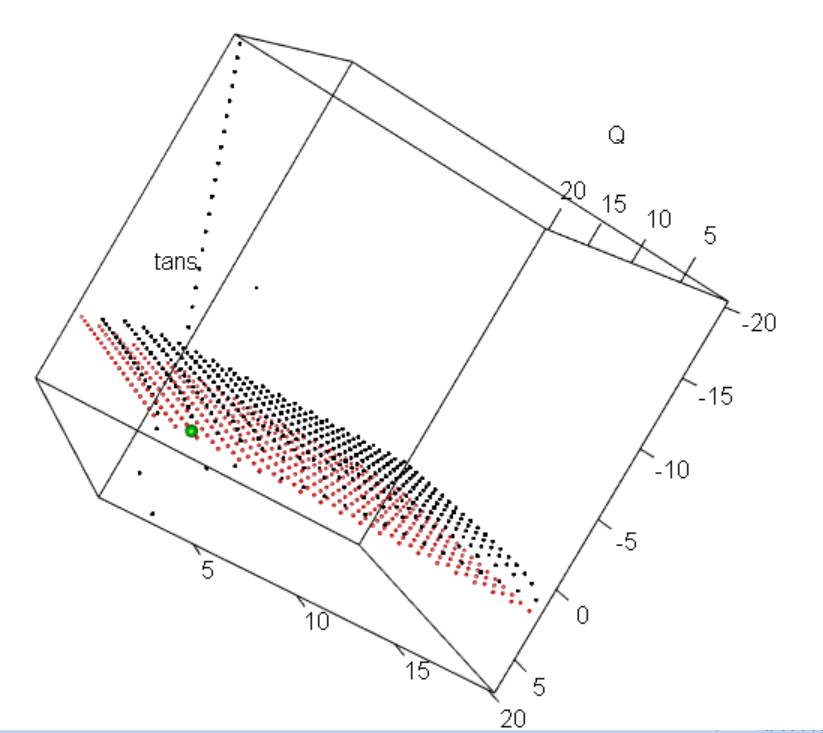
p <- q <- 1:20
pq <- as.matrix(expand.grid(p,q))
P <- pq[,1]
Q <- pq[,2]
alpha <- atan(1/P)
beta <- atan(1/Q)
tans <- tan(alpha+2*beta)
plot3d(P,Q,tans)
spheres3d(P,Q,2,col=2,radius=0.1)
pq[which(abs(tans-2)<10^(-12)),]
- (4)円、三角形、三角関数
- 外接円を原点中心単位円とし、Aを(1,0)に固定して、BをAから外接円周上、半周させる。それに合わせてCを決める
- 円の面積を用いて内接円半径を求め、Aから角Aの二等分線上にしかるべき距離の点として内接円中心を描く


A <- c(1,0)
thetas <- seq(from=0,to=pi,length=31)
thetas <- thetas[-1]
Bs <- cbind(cos(thetas),sin(thetas))
Cs <- matrix(0,length(thetas),2)
Rs <- rep(0,length(thetas))
InCtr <- matrix(0,length(thetas),2)
for(i in 1:length(thetas)){
v.B <- Bs[i,]-A
v.B <- v.B/sqrt(sum(v.B^2))
tmp.phi <- Arg(v.B[1]+1i*v.B[2])
tmp.phi2 <- tmp.phi + pi/3
r <- -2*cos(tmp.phi2)
Cs[i,] <- c(r * cos(tmp.phi2) + 1,r*sin(tmp.phi2))
lenAB <- sqrt(sum((Bs[i,]-A)^2))
lenAC <- sqrt(sum((Cs[i,]-A)^2))
lenBC <- sqrt(sum((Bs[i,]-Cs[i,])^2))
area2 <- lenAB * lenAC * sin(pi/3)
Rs[i] <- area2/(lenAB+lenAC+lenBC)
tmp.phi3 <- tmp.phi + pi/6
InCtr[i,] <- A + (Rs[i]/sin(pi/6)) * c(cos(tmp.phi3),sin(tmp.phi3))
}
t <- seq(from=0,to=2*pi,length=10)
plot(cos(t),sin(t),pch=20,cex=0.1)
for(i in 1:length(thetas)){
segments(A[1],A[2],Bs[i,1],Bs[i,2],col=i)
segments(Bs[i,1],Bs[i,2],Cs[i,1],Cs[i,2],col=i)
segments(A[1],A[2],Cs[i,1],Cs[i,2],col=i)
}
points(InCtr,col=2,pch=20)
plot(thetas,Rs)
- (5)微分積分
- 特定の範囲にひかれた曲線とそれをよぎる直線とに挟まれる領域の面積が直線の傾きによって変化する。面積を最小にする直線は?

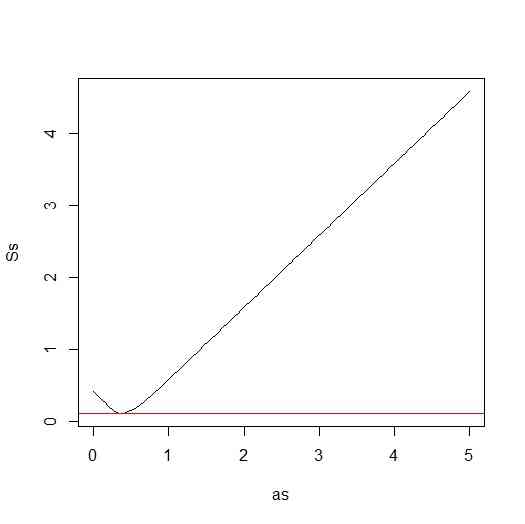
x <- seq(from=0,to=sqrt(2),length=10000)
a <- 0.3
y1 <- x * exp(-x)
y2 <- a * x
plot(x,y1,type="l")
abline(0,a)
abline(v=sqrt(2))
diff.y <- y1-y2
s <- sum(abs(diff.y) * (x[2]-x[1]))
as <- seq(from=0,to=5,length=100)
Ss <- rep(0,length(as))
for(i in 1:length(as)){
a <- as[i]
y2 <- a * x
diff.y <- y1-y2
Ss[i] <- sum(abs(diff.y) * (x[2]-x[1]))
}
plot(as,Ss,type="l")
abline(h=min(Ss),col=2)
min.a <- as[which(Ss==min(Ss))]
a <- min.a
y1 <- x * exp(-x)
y2 <- a * x
plot(x,y1,type="l")
abline(0,a)
abline(v=sqrt(2))
- (6)1,2,3,4,5でできたn桁の自然数が3で割り切れる確率
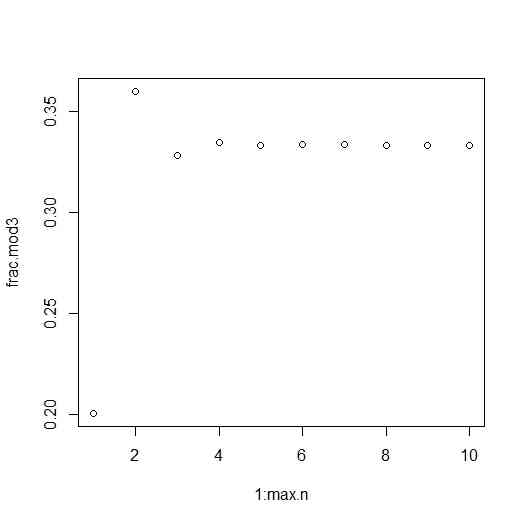
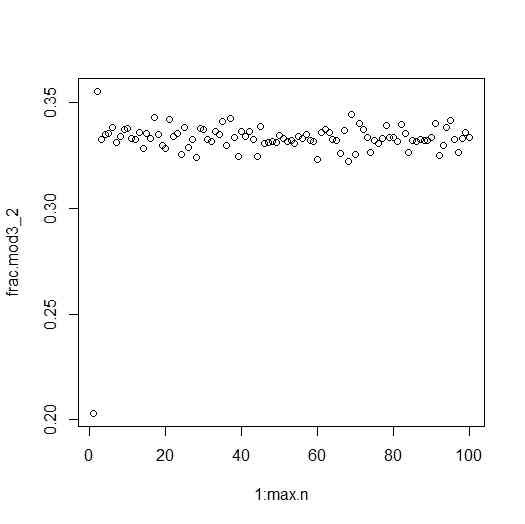
rep.num <- 10^6
max.n <- 10
r <- matrix(sample(1:5,max.n*rep.num,replace=TRUE),ncol=max.n)
frac.mod3 <- rep(0,max.n)
frac.mod3[1] <- length(which(r[,1] %% 3==0))/rep.num
frac.mod3_2 <- frac.mod3
for(i in 2:max.n){
r10 <- r[,1:i] %*% 10^(0:(i-1))
tmp <- r10 %% 3
frac.mod3[i] <- length(which(tmp==0))/rep.num
tmp.sum <- apply(r[,1:i],1,sum)
frac.mod3_2[i] <- length(which(tmp.sum%%3==0))/rep.num
}
plot(1:max.n,frac.mod3)
plot(frac.mod3,frac.mod3_2)
frac.mod3-frac.mod3_2
max.n <- 100
rep.num <- 10^4
r <- matrix(sample(1:5,max.n*rep.num,replace=TRUE),ncol=max.n)
frac.mod3 <- rep(0,max.n)
frac.mod3[1] <- length(which(r[,1] %% 3==0))/rep.num
frac.mod3_2 <- frac.mod3
for(i in 2:max.n){
tmp.sum <- apply(r[,1:i],1,sum)
frac.mod3_2[i] <- length(which(tmp.sum%%3==0))/rep.num
}
plot(1:max.n,frac.mod3_2)











